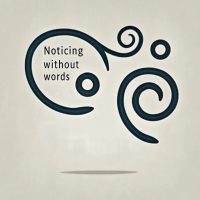Question More, Action Knowledge.
Remember, at QMAK, we don’t just teach; we empower. We don’t just inform; we inspire. We don’t just question; we act. Become a Gold Member, and let’s unlock your child’s full potential, one question at a time.
Back to Mind Explorers
![]()
These games help children develop metacognition, or the ability to think about their own thinking, as well as cultivate a deeper sense of self-awareness and presence.
By exploring the nature of thought and shifting their focus from the content of their thoughts to the space in which they arise, children learn to relate to their mental activity with greater perspective and equanimity.
Practicing noticing and experiencing without words or labels can help children connect more directly with the raw data of their senses and inner world, fostering a sense of immediacy and aliveness.
This can also help them disentangle from the constant stream of mental chatter and find a sense of spaciousness and calm within.
Hey there, young thought explorer!
Today, we're going to play a game called "The Thought Detective."
In this game, we'll be investigating the mystery of our thoughts.
Instead of focusing on what our thoughts are saying, we'll be asking questions about what thoughts are, where they come from, and what they appear to.
We'll also play some other fun games that will help us notice and experience the world around us and inside us in new ways.
Are you ready to put on your detective hat and solve the mystery of thought?1. Encourage the child to ask questions about the nature of thought, such as:
2. Explain that these questions are not meant to be answered with facts, but rather to help shift their focus from the content of thought to the space in which thoughts appear.
3. If the child struggles with the concept of being aware of awareness, introduce the “Noticing and Experiencing” game. Ask the child, “What are you noticing?” and “Who or what is doing the noticing?” or “What are you experiencing?” and “Who or what is doing the experiencing?”

4. Play the “Who’s Noticing That?” game, where the child asks themselves, “Who’s noticing that?” repeatedly, each time referring to the previous “noticer.”

5. Encourage the child to practice “Noticing Without Words” by asking, “What can I notice without words?” or “What can I notice without labeling?”

6. Introduce the “Who Is Experiencing This?” game, where the child asks, “Who or what is experiencing sound, sights, images, bodily sensations, emotions, thoughts, body awareness, and sense of self?”

To further explore the nature of thought and the power of noticing and experiencing without words, consider introducing your child to the book “Silence” by Lemniscates.
This beautifully illustrated book takes children on a mindful journey through the world of silence, inviting them to discover the richness and depth of experience that lies beyond words and concepts. Through simple, poetic language and evocative images, the book encourages children to tune into the subtle sensations, emotions, and insights that arise when they allow themselves to be fully present with what is.
1. What does the book encourage children to do?
a) Make as much noise as possible
b) Listen to silence
c) Ignore their surroundings
d) Talk constantly
2. According to the book, where can we find silence?
a) Only in empty rooms
b) Nowhere
c) In many places, even in seemingly noisy environments
d) Only at night
3. What does the book say about silence in nature?
a) Nature is always loud
b) Silence can be found in nature if we listen carefully
c) There is no silence in nature
d) Only deserts are silent
4. How does the book describe the sound of a heartbeat?
a) As a disruption to silence
b) As a rhythm we can listen to in silence
c) As something to ignore
d) As too quiet to hear
5. What does the book suggest about listening to our own thoughts?
a) We should avoid thinking
b) Our thoughts are always too loud
c) We can hear our thoughts in silence
d) Thoughts only come when it’s noisy
6. How does the book portray silence in relation to feelings?
a) Silence and feelings are unrelated
b) We can understand our feelings better in silence
c) Feelings only exist when there’s noise
d) Silence eliminates all feelings
7. What does the book say about silence and imagination?
a) Silence stifles imagination
b) Imagination only works with noise
c) Silence can help our imagination flourish
d) Imagination and silence cannot coexist
8. How does the book describe the experience of being silent?
a) As boring and unproductive
b) As peaceful and enriching
c) As frightening
d) As impossible to achieve
9. What does the book suggest about the relationship between silence and understanding others?
a) Silence prevents understanding
b) We need constant talking to understand others
c) Silence can help us understand others better
d) Understanding others is not important
10. What is the main message of “Silence”?
a) Noise is always better than silence
b) Silence is valuable and can help us connect with ourselves and the world
c) Children should be quiet all the time
d) Listening is not an important skill
1. b) Listen to silence
2. c) In many places, even in seemingly noisy environments
3. b) Silence can be found in nature if we listen carefully
4. b) As a rhythm we can listen to in silence
5. c) We can hear our thoughts in silence
6. b) We can understand our feelings better in silence
7. c) Silence can help our imagination flourish
8. b) As peaceful and enriching
9. c) Silence can help us understand others better
10. b) Silence is valuable and can help us connect with ourselves and the world
Verse 1:
Where do thoughts come from?
What are they made of?
Who’s the one noticing?
These questions we’ll love
Pre-Chorus:
Look beyond the words
To the space where they bloom
Chorus:
I’m a thought detective, on the case
Searching for clues in every place
What am I noticing? Who’s noticing me?
Unraveling the mystery of who I might be
Verse 2:
Can you see without naming?
Can you hear without words?
Who’s feeling the feelings?
Who’s thinking what’s heard?
(Pre-Chorus)
(Chorus)
Bridge:
Behind every thought, behind every sound
There’s a silent watcher to be found
Not in words, not in sight
But in the awareness shining bright
(Chorus)
Outro:
The mystery deepens, but that’s okay
We’re explorers of the mind today
In the space between thoughts, we might just see
A glimpse of the true mystery of me
Remember, at QMAK, we don’t just teach; we empower. We don’t just inform; we inspire. We don’t just question; we act. Become a Gold Member, and let’s unlock your child’s full potential, one question at a time.